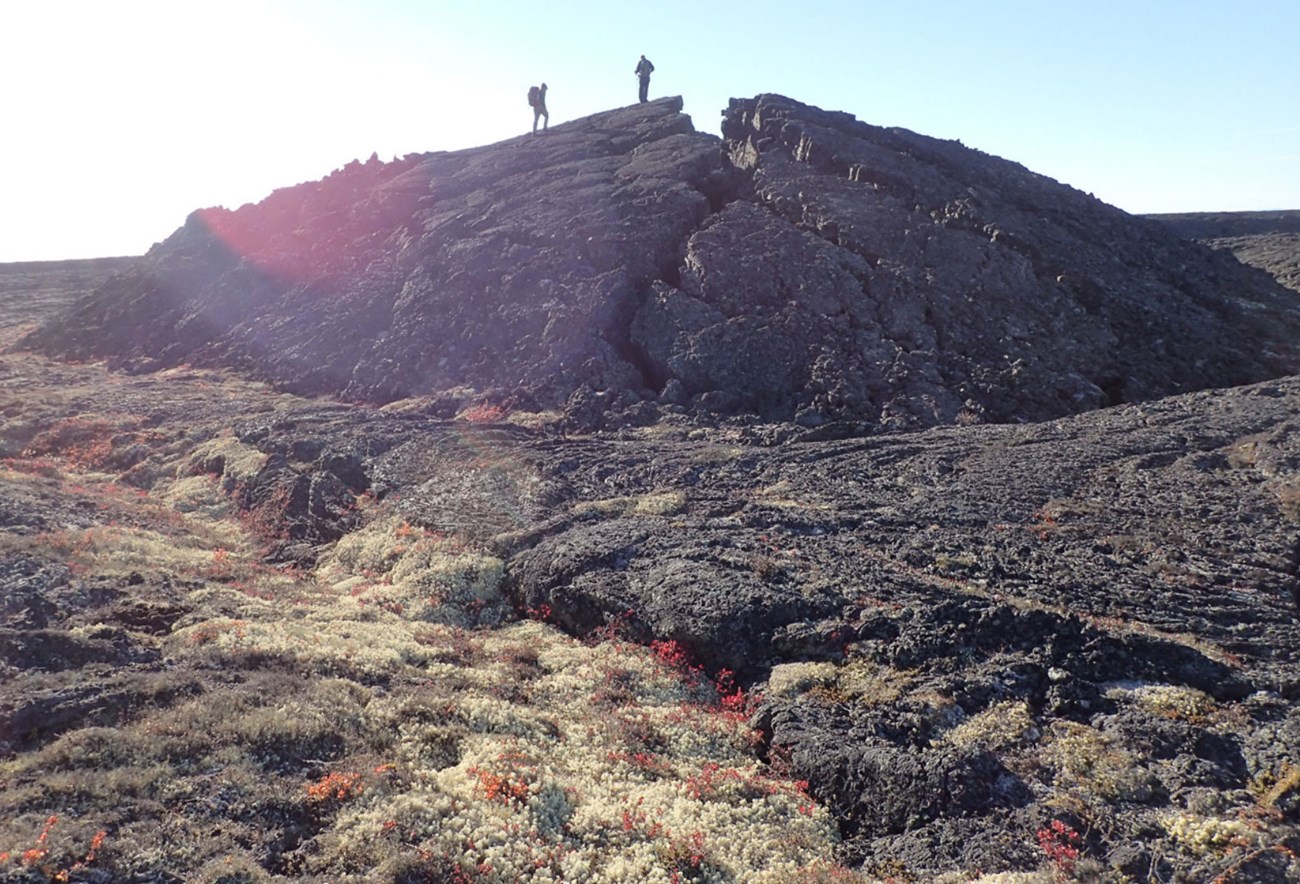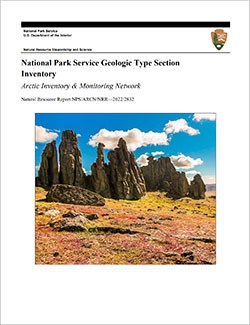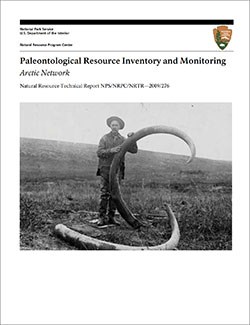
NPS photo by David Swanson.
Geology and Stratigraphy of the Arctic I&M Network Parks
The Arctic Inventory & Monitoring Network (ARCN) consists of five National Park Service units in northwestern and north-central Alaska. These parks include Bering Land Bridge National Preserve, Cape Krusenstern National Monument, Gates of the Arctic National Park and Preserve, Kobuk Valley National Park, and Noatak National Preserve. The parks of the Arctic Network includes some of the nation’s largest national parks, with Gates of the Arctic being the second largest national park covering 3,428,702 ha (8,472,506 acres), and Noatak being not far behind at 2,660,598 ha (6,574,481 acres).
The Arctic Network parks are inaccessible by road and offer visitors tremendous opportunities for wilderness experiences. The parks associated with the Brooks Range offer an outstanding wilderness landscape with abundant wildlife and other natural resources. All of these parks, with the exception of Bering Land Bridge, lie north of the Arctic Circle and are in or directly adjacent to the Brooks Range, a broad area of uplifted Paleozoic bedrock that forms an east– west trending mountain range across northern Alaska. The geographic area covered by the Arctic Network can be divided into a series of east–west trending geologic provinces (Blodgett et al. 2002). These provinces are defined by stratigraphy, structural character, and degree of metamorphism. They primarily reflect the deformational history related to the formation of the Brooks Range.
A Brief Geologic History
A few examples of events and Network resources in each geologic time period are highlighted below, from youngest to oldest.
The Cenozoic of the Arctic Network parks is represented by Neogene units spanning between the Miocene through the Holocene. The oldest Cenozoic units documented in the network are a sequence of Miocene–Pleistocene gravels at Bering Land Bridge. All of the network parks have unnamed Quaternary deposits (Hamilton 2010; Hamilton and Labay 2012).
The oldest Mesozoic rocks in the Arctic Network parks include the Middle–Late Triassic Shublik Formation in Gates of the Arctic. The Otuk Formation is a Late Triassic–Middle Jurassic unit which is mapped in both Gates of the Arctic and Noatak. The Early Cretaceous is represented by the Okpikruak Formation also exposed within Gates of the Arctic and Noatak. Additional Early Cretaceous units in Gates of the Arctic include an unnamed coquinoid limestone and the Fortress Mountain Formation. An unnamed sedimentary unit of Early– Late Cretaceous age is present at Kobuk Valley.
Lower Paleozoic rocks are found in every Arctic Network park. The Baird Group is a widespread Cambrian– Late Devonian unit exposed in Cape Krusenstern, Gates of the Arctic, Kobuk Valley, and Noatak. The Nome Complex is an upper Precambrian–Devonian-age unit exposed in Bering Land Bridge. Within Kobuk Valley the Skajit Limestone (Middle Ordovician–Middle Devonian) and informal “Twilight Zone” strata of Middle Ordovician–Early Mississippian age are also present.
The Devonian is well-exposed in all of the Arctic Network parks. Devonian-age metamorphic rocks of the Nome Complex underlie portions of Bering Land Bridge. The Late Devonian Kanayut Conglomerate and Hunt Fork Shale are mapped in Cape Krusenstern, Gates of the Arctic, and Noatak. The Noatak Sandstone is present in Gates of the Arctic and Noatak. Additional Devonian units include the Beaucoup Formation (Gates of the Arctic), and Eli Limestone and Kugururok Formation (Noatak).
The Carboniferous is also exposed in each of the network parks with the exception of Bering Land Bridge. The Mississippian and Pennsylvanian are represented by the Noatak Sandstone, Kayak Shale, Utukok Formation, and Kogruk Formation in Cape Krusenstern; the Kayak Shale, Lisburne Group, Wachsmuth Limestone, Alapah Limestone, Kuna Formation, and Nuka Formation in Gates of the Arctic; the Lisburne Group in Kobuk Valley; and the Kayak Shale, Lisburne Group, Utukok Formation, Kogruk Formation, Wachsmuth Limestone, Kuna Formation, Nuka Formation, and Siksikpuk Formation in Noatak.
Permian-age strata underlie two Arctic Network parks. The Siksikpuk Formation is mapped in both Noatak and Gates of the Arctic. Gates of the Arctic also has rocks of the Sadlerochit Group, and additional Permian units in Noatak include the Nuka Formation and Etivluk Group.
Precambrian-age rocks are not well-represented in the parks of the Arctic Network. The Erie Lake pluton in Gates of the Arctic is believed to be Mesoproterozoic in age. Neoproterozoic metasedimentary and metavolcanic rocks occur within Kobuk Valley and Noatak. The Nome Complex metamorphic and metavolcanic rocks present in Bering Land Bridge span from the Precambrian into the middle Paleozoic.
Geology & Soils—Arctic Network Parks
Type Sections—Arctic Network

The geologic history above is excerpted from a report titled, "National Park Service Geologic Type Section Inventory: Arctic Inventory & Monitoring Network". Type sections are essential reference locations for the geoscientists who study geologic history and paleontology. A summary of the type sections in each park can be found at the links below.
-
Bering Land Bridge National Preserve, Alaska [Site Under Development]
-
Cape Krusenstern National Monument, Alaska (no designated stratotypes identified)
-
Gates of the Arctic National Park and Preserve, Alaska [Site Under Development]
-
Kobuk Valley National Park, Alaska (no designated stratotypes identified)
-
Noatak National Preserve, Alaska [Site Under Development]
The full Network report is available in digital format from:
Please cite this publication as:
-
Henderson TC, Santucci VL, Connors T, Tweet JS. 2022. National Park Service geologic type section inventory: Arctic Inventory & Monitoring Network. Natural Resource Report. NPS/ARCN/NRR—2022/2832. National Park Service. Fort Collins, Colorado.
NPS Stratotype Inventory
Fossil Resources—Arctic Network

Between 2002 and 2011, network-based paleontological resource inventories were completed for all the 32 I&M networks, and six of the earliest were completely updated between 2012 and 2016. The report linked below summarizes the paleontological resources of all park units in the Arctic Inventory & Monitoring Network (ARCN). The report provides geologic background and paleontological resource data for each park to support management operations, planning, and science-based decision making as required by NPS management policies and the Paleontological Resources Preservation Act (2009).
The full report is available in digital format from
Please cite this publication as:
-
Elder, W., V. L. Santucci, J. P. Kenworthy, R. B. Blodgett, and R. T. P. McKenna. 2009. Paleontological resource inventory and monitoring—Arctic Network. Natural Resource Technical Report NPS/NRPC/NRTR—2009/276. National Park Service, Fort Collins, Colorado.
Geodiversity Atlas pages—by Inventory & Monitoring Network
Appalachian Highlands Network Index
Arctic Network Index*
Central Alaska Network Index
Chihuahuan Desert Network Index*
Cumberland Piedmont Network Index
Eastern Rivers and Mountains Network Index
Great Lakes Network Index
Greater Yellowstone Network Index**
Gulf Coast Network Index*
Heartland Network Index
Klamath Network Index
Mediterranean Coast Network Index
Mid-Atlantic Network Index
Mojave Desert Network Index
National Capital Network Index
North Coast and Cascades Network Index
Northeast Coastal and Barrier Network Index
Northeast Temperate Network Index
Northern Colorado Plateau Network Index*
Northern Great Plains Network Index*
Pacific Islands Network Index
Rocky Mountain Network Index**
San Francisco Bay Area Network Index
Sierra Nevada Network Index
Sonoran Desert Network Index*
South Florida/Caribbean Network Index
Southeast Alaska Network Index
Southeast Coast Network Index
Southern Colorado Plateau Network Index*
Southern Plains Network Index*
Southwest Alaska Network Index
Upper Columbia Basin Network Index
Geodiversity Atlas pages—by State, U.S. Commonwealth, and Territories
Alabama | Alaska | Arizona | Arkansas | California | Colorado | Connecticut | District of Columbia | Delaware | Florida | Georgia | Hawaii | Idaho | Illinois | Indiana | Iowa | Kansas | Kentucky | Louisiana | Maine | Maryland | Massachusetts | Michigan | Minnesota | Mississippi | Missouri | Montana | Nebraska | Nevada | New Hampshire | New Jersey | New Mexico | New York | North Carolina | North Dakota | Ohio | Oklahoma | Oregon | Pennsylvania | Rhode Island | South Carolina | South Dakota | Tennessee | Texas | Utah | Vermont | Virginia | Washington | West Virginia | Wisconsin | Wyoming
U.S. Commonwealth and Territories
Geodiversity Atlas pages—by Unified Interior Regions
Region 1: North Atlantic-Appalachian
Region 2: South Atlantic-Gulf (Includes Puerto Rico and the U.S. Virgin Islands)
Region 3: Great Lakes
Region 4: Mississippi Basin
Region 5: Missouri Basin
Region 6: Arkansas-Rio Grande-Texas-Gulf
Region 7: Upper Colorado Basin
Region 8: Lower Colorado Basin
Region 9: Columbia-Pacific Northwest
Region 10: California-Great Basin
Region 11: Alaska
Region 12: Pacific Islands (American Samoa, Hawaii. Guam, Commonwealth of the Northern Mariana Islands)
Last updated: February 21, 2025
